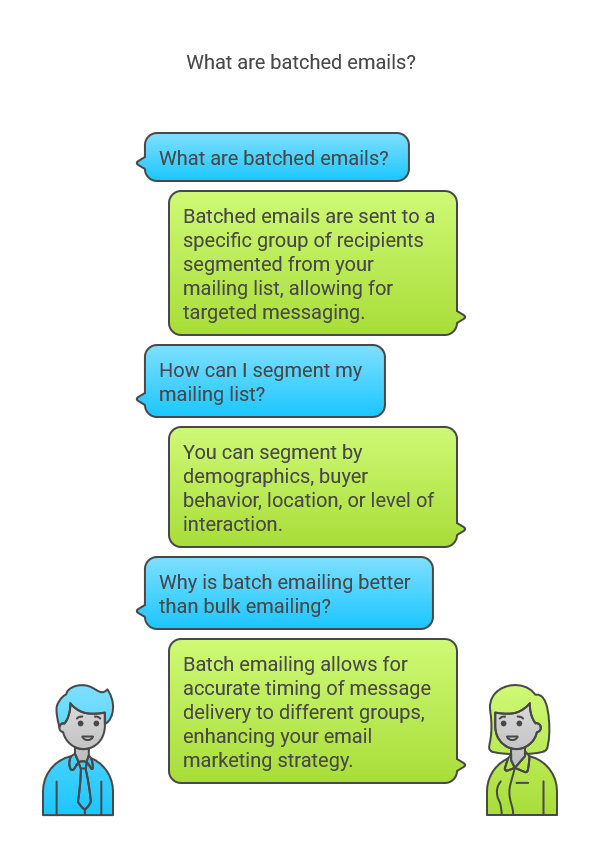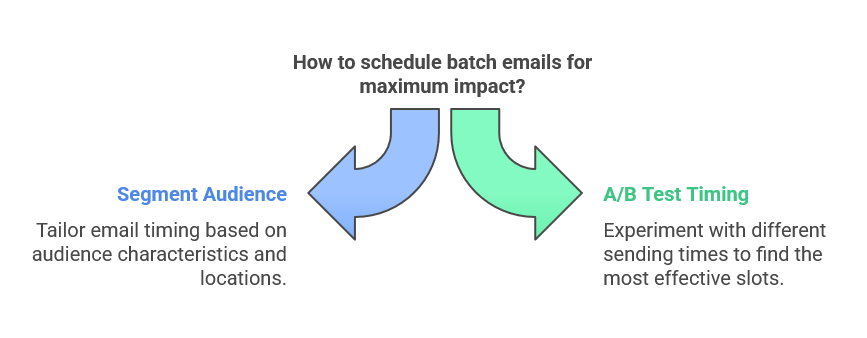Making sure an email isn’t lost in a crowded inbox is one of the main challenges of email marketing. There’s no way the marketing team can guess when the recipient will check his email. Whether the recipients choose to respond or not is completely up to them.
That said, there are a few things that can be safely assumed.
An email that is delivered at 3 am isn’t likely to be read immediately. Even if emails are the first thing the recipient checks on waking up, this email may not be at the top of their inbox.
It’s evident that choosing the right time to send an email is important. But, when you’re sending out emails to 5000 people at once, how do you make sure you time the delivery right? The solution lies in batching emails.
What are batched emails?
Simply put, batched emails refer to emails sent to a ‘batch’ or group of recipients segmented out of your mailing list. You can segment a mailing list into different groups depending on demographics, buyer behavior, location, level of interaction, etc. Unlike bulk emailing, batch emailing allows for your targeted messaging.
For example, 2000 of the 5000 emails on your mailing list may belong to customers in India, 1500 to customers in Australia and 1500 to customers in the UK. Each of these groups lives in a different time zone. Hence, rather than sending a bulk email to all 5000 at once, sending emails in batches allows you to accurately time the delivery of your message. This could be a game-changer for your email marketing strategy.

How are batched emails beneficial?
Whether you send an email once a week or once a month, studies show that sending emails in batches can result in 50% more clickthroughs as compared to a bulk email blast. Your emails are more likely to be seen and thus engaged with. Apart from this, there are many other benefits such as:
Safer sender reputation
A sudden spike in the number of emails sent out can make your IP address stand out. It may flood the client servers and increase your risk of being flagged as spam. As a result, your emails may be relegated to the customer’s spam folder.
On the other hand, sending emails in batches helps maintain a consistent sending pattern. This plays an important role in keeping your emails out of the spam folder and maintaining a good sender reputation. In turn, there’s a lower risk of being blacklisted by email servers.
Balanced website traffic
In most cases, you don’t want the audience to just read an email. You want them to click on a product link or take other actions to engage with the email. In most cases, you want the customer to get to your website. That said, your website can handle limited traffic. A sudden influx may overwhelm the website servers and lead to a crash.
Sending emails in batches at different times helps avoid this. This smoothens the sudden rise and fall of traffic to a gentler flow that is easier to manage. This can be very important when you’re launching new collections or announcing a sale.
Better quality control
Everyone makes mistakes. A small spelling mistake can become embarrassing. Sending an email out with a broken link could make the entire campaign ineffective. Sending emails in batches gives you the opportunity to catch such mistakes early.
Let’s say you sent out an email without a Call-to-Action button to 100 people. A quick glance at the campaign analytics would indicate that something went wrong. You could then rectify the error and ensure that the email sent to everyone else has a functional Call-to-Action button. Thus, it saves you from potentially embarrassing situations.
Scheduling Batch Emails
To maximize the impact of sending emails in batches, you must hit the send button at the right time. Here are a few tips:

Segment the audience
Begin by segmenting your audience. In the case of an international audience, segmenting by country is the easiest way to start. In the case of countries like the USA that fall into multiple time zones, you could segment the audience by states.
Segmentation and timing are important even when you’re dealing with customers in a single time zone. For example, working professionals may check their email on their daily commute while stay-at-home mothers may find time in the afternoon to check their emails.
Set up an A/B test
Once you have segmented the mailing list, the next step is to determine the best time to send an email. 9 am to 3 pm on a Tuesday is assumed to be the best time to send a marketing email but this may not work for all industries.
Experiment with different time slots across different days of the week and note the response for each. By analyzing the open and click rates for each time slot, you will be able to ascertain the best time to send emails to each segment of your audience.
Want to try batch emailing – start with a clean email list
Sending emails in multiple batches rather than as a single blast email campaign maximizes the efficacy of email campaigns. By considering factors like time zones, recipient behavior, and campaign relevance, you can ensure that your emails are sent at the most opportune moments, leading to higher engagement and better overall results. That said, this works only if your emails reach the intended customer.
Having a clean mailing list is critical to a successful batch email strategy. With the help of an email verification tool, you can clean your mailing list of typographic and syntax errors, remove duplicates and confirm that all the addresses on your list are deliverable. Investing this effort and time into verification and segmentation goes a long way towards achieving marketing goals, safeguarding your sender reputation and enjoying long-term customer relationships.
So, the next time you plan an email campaign—and ideally, with a meticulously clean list—consider batch emailing. Your metrics will shine, and your team will appreciate the results.